light FIAT DOBLO COMBI 2018 Owner handbook (in English)
[x] Cancel search | Manufacturer: FIAT, Model Year: 2018, Model line: DOBLO COMBI, Model: FIAT DOBLO COMBI 2018Pages: 272, PDF Size: 23.75 MB
Page 81 of 272
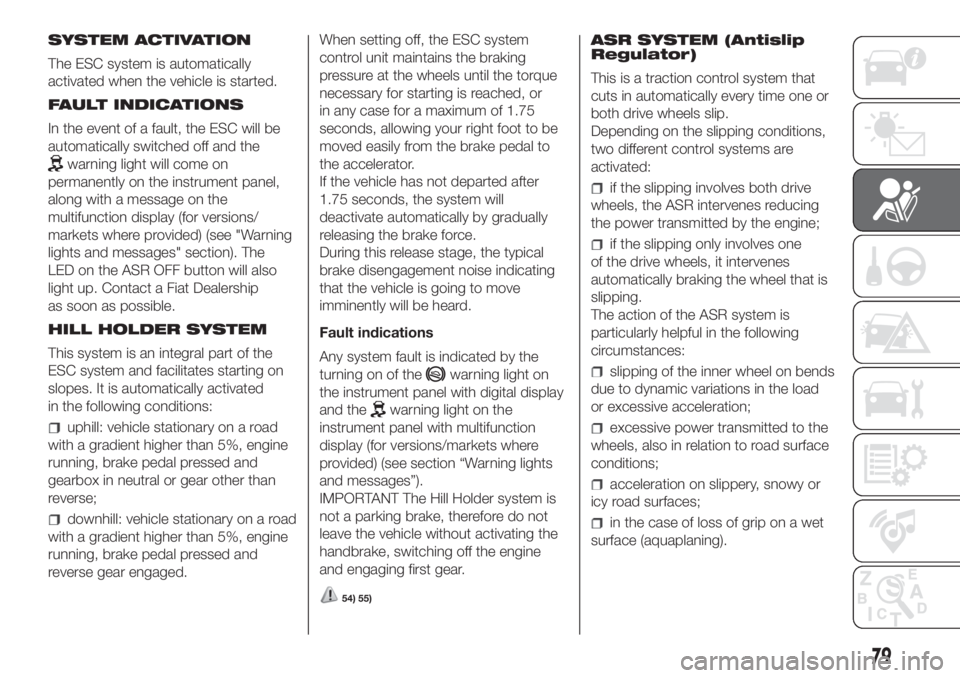
SYSTEM ACTIVATION
The ESC system is automatically
activated when the vehicle is started.
FAULT INDICATIONS
In the event of a fault, the ESC will be
automatically switched off and the
warning light will come on
permanently on the instrument panel,
along with a message on the
multifunction display (for versions/
markets where provided) (see "Warning
lights and messages" section). The
LED on the ASR OFF button will also
light up. Contact a Fiat Dealership
as soon as possible.
HILL HOLDER SYSTEM
This system is an integral part of the
ESC system and facilitates starting on
slopes. It is automatically activated
in the following conditions:
uphill: vehicle stationary on a road
with a gradient higher than 5%, engine
running, brake pedal pressed and
gearbox in neutral or gear other than
reverse;
downhill: vehicle stationary on a road
with a gradient higher than 5%, engine
running, brake pedal pressed and
reverse gear engaged.When setting off, the ESC system
control unit maintains the braking
pressure at the wheels until the torque
necessary for starting is reached, or
in any case for a maximum of 1.75
seconds, allowing your right foot to be
moved easily from the brake pedal to
the accelerator.
If the vehicle has not departed after
1.75 seconds, the system will
deactivate automatically by gradually
releasing the brake force.
During this release stage, the typical
brake disengagement noise indicating
that the vehicle is going to move
imminently will be heard.
Fault indications
Any system fault is indicated by the
turning on of the
warning light on
the instrument panel with digital display
and the
warning light on the
instrument panel with multifunction
display (for versions/markets where
provided) (see section “Warning lights
and messages”).
IMPORTANT The Hill Holder system is
not a parking brake, therefore do not
leave the vehicle without activating the
handbrake, switching off the engine
and engaging first gear.
54) 55)
ASR SYSTEM (Antislip
Regulator)
This is a traction control system that
cuts in automatically every time one or
both drive wheels slip.
Depending on the slipping conditions,
two different control systems are
activated:
if the slipping involves both drive
wheels, the ASR intervenes reducing
the power transmitted by the engine;
if the slipping only involves one
of the drive wheels, it intervenes
automatically braking the wheel that is
slipping.
The action of the ASR system is
particularly helpful in the following
circumstances:
slipping of the inner wheel on bends
due to dynamic variations in the load
or excessive acceleration;
excessive power transmitted to the
wheels, also in relation to road surface
conditions;
acceleration on slippery, snowy or
icy road surfaces;
in the case of loss of grip on a wet
surface (aquaplaning).
79
Page 82 of 272
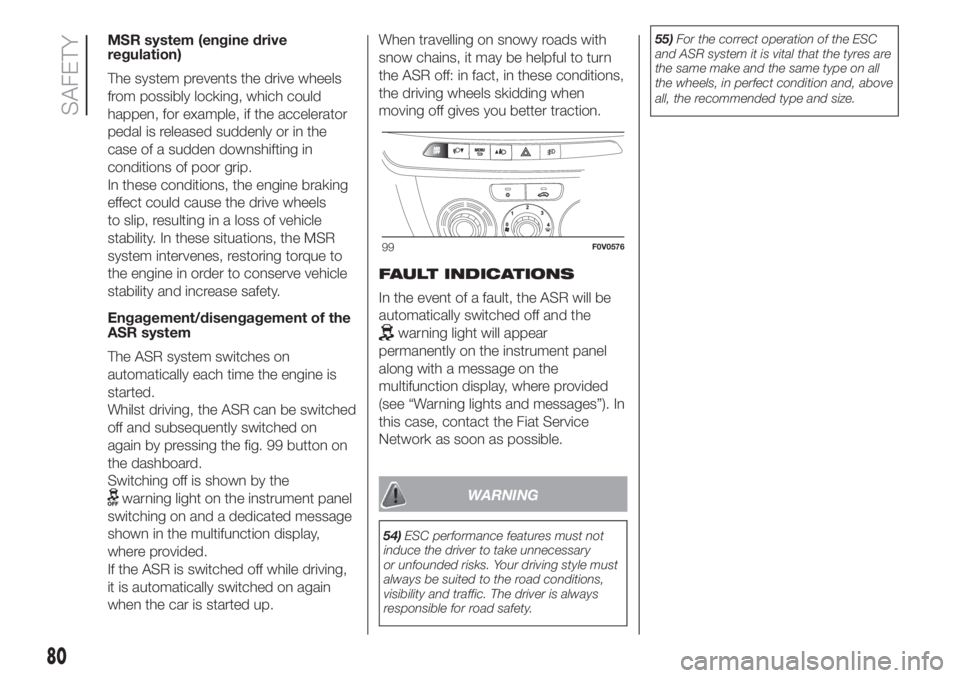
MSR system (engine drive
regulation)
The system prevents the drive wheels
from possibly locking, which could
happen, for example, if the accelerator
pedal is released suddenly or in the
case of a sudden downshifting in
conditions of poor grip.
In these conditions, the engine braking
effect could cause the drive wheels
to slip, resulting in a loss of vehicle
stability. In these situations, the MSR
system intervenes, restoring torque to
the engine in order to conserve vehicle
stability and increase safety.
Engagement/disengagement of the
ASR system
The ASR system switches on
automatically each time the engine is
started.
Whilst driving, the ASR can be switched
off and subsequently switched on
again by pressing the fig. 99 button on
the dashboard.
Switching off is shown by the
warning light on the instrument panel
switching on and a dedicated message
shown in the multifunction display,
where provided.
If the ASR is switched off while driving,
it is automatically switched on again
when the car is started up.When travelling on snowy roads with
snow chains, it may be helpful to turn
the ASR off: in fact, in these conditions,
the driving wheels skidding when
moving off gives you better traction.
FAULT INDICATIONS
In the event of a fault, the ASR will be
automatically switched off and the
warning light will appear
permanently on the instrument panel
along with a message on the
multifunction display, where provided
(see “Warning lights and messages”). In
this case, contact the Fiat Service
Network as soon as possible.
WARNING
54)ESC performance features must not
induce the driver to take unnecessary
or unfounded risks. Your driving style must
always be suited to the road conditions,
visibility and traffic. The driver is always
responsible for road safety.55)For the correct operation of the ESC
and ASR system it is vital that the tyres are
the same make and the same type on all
the wheels, in perfect condition and, above
all, the recommended type and size.
99F0V0576
80
SAFETY
Page 85 of 272
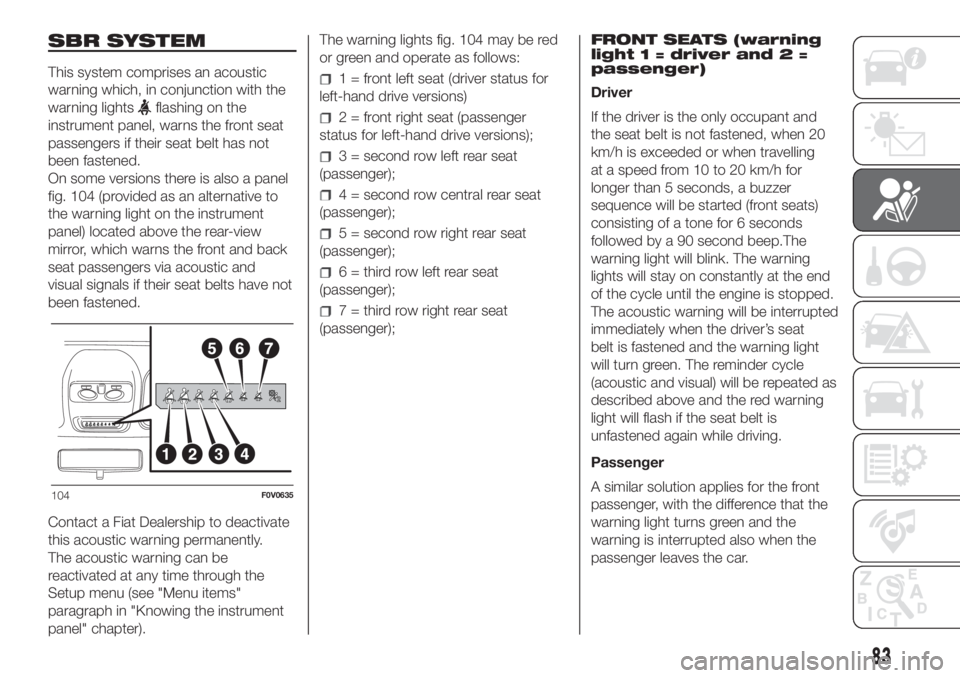
SBR SYSTEM
This system comprises an acoustic
warning which, in conjunction with the
warning lights
flashing on the
instrument panel, warns the front seat
passengers if their seat belt has not
been fastened.
On some versions there is also a panel
fig. 104 (provided as an alternative to
the warning light on the instrument
panel) located above the rear-view
mirror, which warns the front and back
seat passengers via acoustic and
visual signals if their seat belts have not
been fastened.
Contact a Fiat Dealership to deactivate
this acoustic warning permanently.
The acoustic warning can be
reactivated at any time through the
Setup menu (see "Menu items"
paragraph in "Knowing the instrument
panel" chapter).The warning lights fig. 104 may be red
or green and operate as follows:
1 = front left seat (driver status for
left-hand drive versions)
2 = front right seat (passenger
status for left-hand drive versions);
3 = second row left rear seat
(passenger);
4 = second row central rear seat
(passenger);
5 = second row right rear seat
(passenger);
6 = third row left rear seat
(passenger);
7 = third row right rear seat
(passenger);FRONT SEATS (warning
light 1 = driver and 2 =
passenger)
Driver
If the driver is the only occupant and
the seat belt is not fastened, when 20
km/h is exceeded or when travelling
at a speed from 10 to 20 km/h for
longer than 5 seconds, a buzzer
sequence will be started (front seats)
consisting of a tone for 6 seconds
followed by a 90 second beep.The
warning light will blink. The warning
lights will stay on constantly at the end
of the cycle until the engine is stopped.
The acoustic warning will be interrupted
immediately when the driver’s seat
belt is fastened and the warning light
will turn green. The reminder cycle
(acoustic and visual) will be repeated as
described above and the red warning
light will flash if the seat belt is
unfastened again while driving.
Passenger
A similar solution applies for the front
passenger, with the difference that the
warning light turns green and the
warning is interrupted also when the
passenger leaves the car.
104F0V0635
83
Page 86 of 272
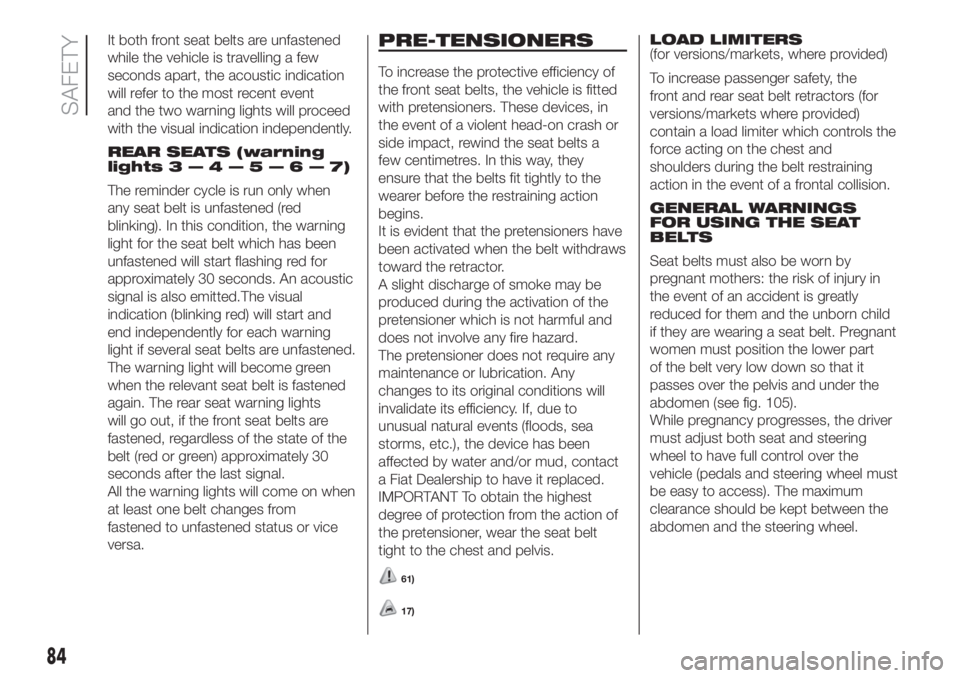
It both front seat belts are unfastened
while the vehicle is travelling a few
seconds apart, the acoustic indication
will refer to the most recent event
and the two warning lights will proceed
with the visual indication independently.
REAR SEATS (warning
lights3—4—5—6—7)
The reminder cycle is run only when
any seat belt is unfastened (red
blinking). In this condition, the warning
light for the seat belt which has been
unfastened will start flashing red for
approximately 30 seconds. An acoustic
signal is also emitted.The visual
indication (blinking red) will start and
end independently for each warning
light if several seat belts are unfastened.
The warning light will become green
when the relevant seat belt is fastened
again. The rear seat warning lights
will go out, if the front seat belts are
fastened, regardless of the state of the
belt (red or green) approximately 30
seconds after the last signal.
All the warning lights will come on when
at least one belt changes from
fastened to unfastened status or vice
versa.
84
SAFETY
PRE-TENSIONERS
To increase the protective efficiency of
the front seat belts, the vehicle is fitted
with pretensioners. These devices, in
the event of a violent head-on crash or
side impact, rewind the seat belts a
few centimetres. In this way, they
ensure that the belts fit tightly to the
wearer before the restraining action
begins.
It is evident that the pretensioners have
been activated when the belt withdraws
toward the retractor.
A slight discharge of smoke may be
produced during the activation of the
pretensioner which is not harmful and
does not involve any fire hazard.
The pretensioner does not require any
maintenance or lubrication. Any
changes to its original conditions will
invalidate its efficiency. If, due to
unusual natural events (floods, sea
storms, etc.), the device has been
affected by water and/or mud, contact
a Fiat Dealership to have it replaced.
IMPORTANT To obtain the highest
degree of protection from the action of
the pretensioner, wear the seat belt
tight to the chest and pelvis.
61)
17)
LOAD LIMITERS
(for versions/markets, where provided)
To increase passenger safety, the
front and rear seat belt retractors (for
versions/markets where provided)
contain a load limiter which controls the
force acting on the chest and
shoulders during the belt restraining
action in the event of a frontal collision.
GENERAL WARNINGS
FOR USING THE SEAT
BELTS
Seat belts must also be worn by
pregnant mothers: the risk of injury in
the event of an accident is greatly
reduced for them and the unborn child
if they are wearing a seat belt. Pregnant
women must position the lower part
of the belt very low down so that it
passes over the pelvis and under the
abdomen (see fig. 105).
While pregnancy progresses, the driver
must adjust both seat and steering
wheel to have full control over the
vehicle (pedals and steering wheel must
be easy to access). The maximum
clearance should be kept between the
abdomen and the steering wheel.
Page 91 of 272
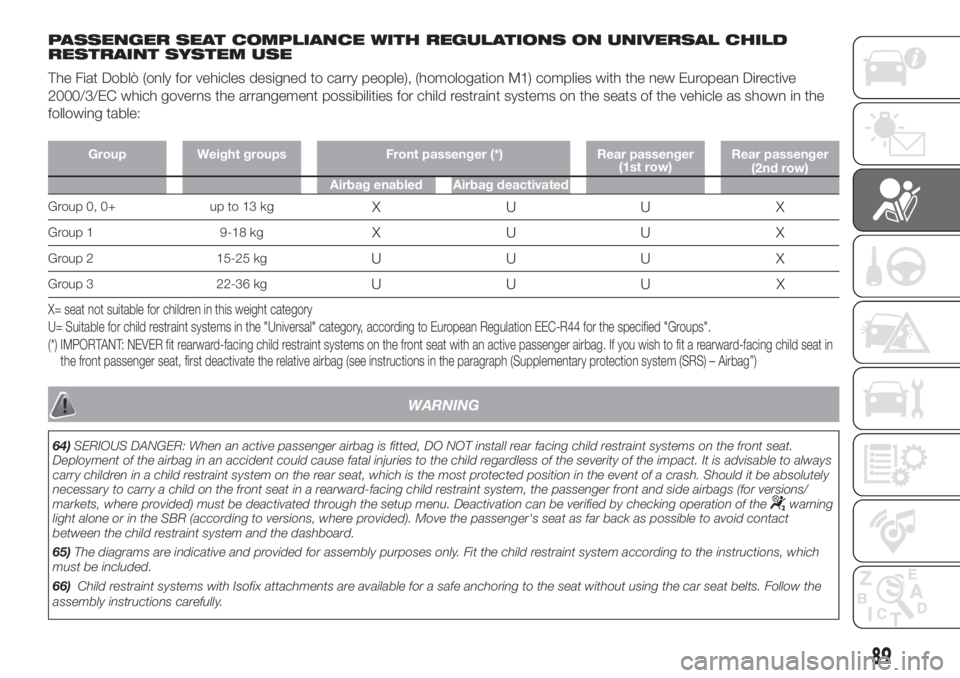
PASSENGER SEAT COMPLIANCE WITH REGULATIONS ON UNIVERSAL CHILD
RESTRAINT SYSTEM USE
The Fiat Doblò (only for vehicles designed to carry people), (homologation M1) complies with the new European Directive
2000/3/EC which governs the arrangement possibilities for child restraint systems on the seats of the vehicle as shown in the
following table:
Group Weight groups Front passenger (*) Rear passenger
(1st row)Rear passenger
(2nd row)
Airbag enabled Airbag deactivated
Group 0, 0+ up to 13 kgXUUX
Group 1 9-18 kgXUUX
Group 2 15-25 kgUUU X
Group 3 22-36 kgUUU X
X= seat not suitable for children in this weight category
U= Suitable for child restraint systems in the "Universal" category, according to European Regulation EEC-R44 for the specified "Groups".
(*) IMPORTANT: NEVER fit rearward-facing child restraint systems on the front seat with an active passenger airbag. If you wish to fit a rearward-facing child seat in
the front passenger seat, first deactivate the relative airbag (see instructions in the paragraph (Supplementary protection system (SRS) – Airbag”)
WARNING
64)SERIOUS DANGER: When an active passenger airbag is fitted, DO NOT install rear facing child restraint systems on the front seat.
Deployment of the airbag in an accident could cause fatal injuries to the child regardless of the severity of the impact. It is advisable to always
carry children in a child restraint system on the rear seat, which is the most protected position in the event of a crash. Should it be absolutely
necessary to carry a child on the front seat in a rearward-facing child restraint system, the passenger front and side airbags (for versions/
markets, where provided) must be deactivated through the setup menu. Deactivation can be verified by checking operation of the
warning
light alone or in the SBR (according to versions, where provided). Move the passenger's seat as far back as possible to avoid contact
between the child restraint system and the dashboard.
65)The diagrams are indicative and provided for assembly purposes only. Fit the child restraint system according to the instructions, which
must be included.
66)Child restraint systems with Isofix attachments are available for a safe anchoring to the seat without using the car seat belts. Follow the
assembly instructions carefully.
89
Page 97 of 272
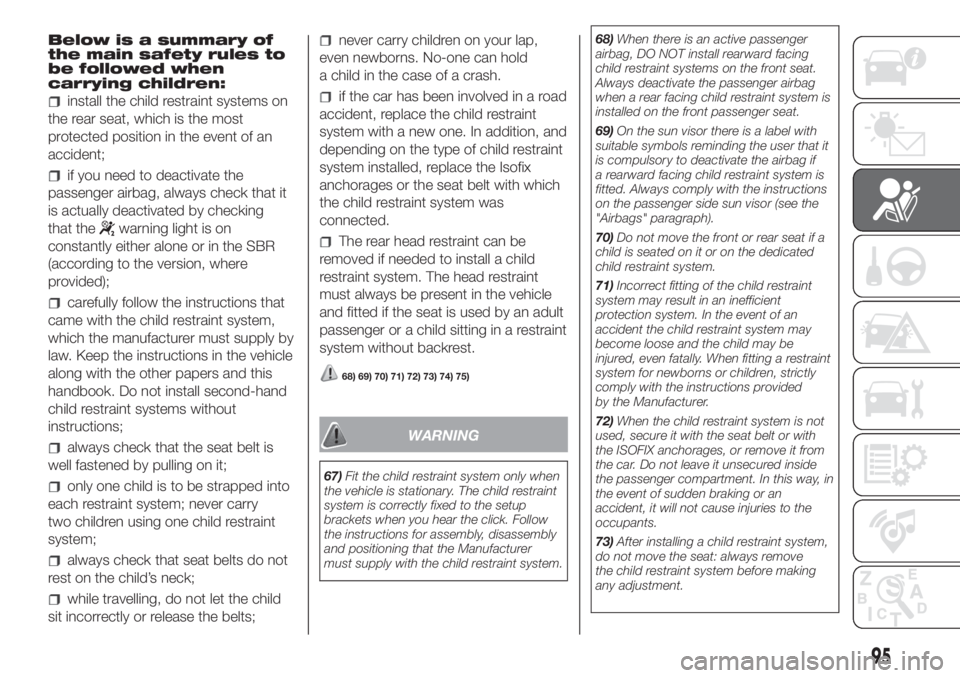
Below is a summary of
the main safety rules to
be followed when
carrying children:
install the child restraint systems on
the rear seat, which is the most
protected position in the event of an
accident;
if you need to deactivate the
passenger airbag, always check that it
is actually deactivated by checking
that the
warning light is on
constantly either alone or in the SBR
(according to the version, where
provided);
carefully follow the instructions that
came with the child restraint system,
which the manufacturer must supply by
law. Keep the instructions in the vehicle
along with the other papers and this
handbook. Do not install second-hand
child restraint systems without
instructions;
always check that the seat belt is
well fastened by pulling on it;
only one child is to be strapped into
each restraint system; never carry
two children using one child restraint
system;
always check that seat belts do not
rest on the child’s neck;
while travelling, do not let the child
sit incorrectly or release the belts;
never carry children on your lap,
even newborns. No-one can hold
a child in the case of a crash.
if the car has been involved in a road
accident, replace the child restraint
system with a new one. In addition, and
depending on the type of child restraint
system installed, replace the Isofix
anchorages or the seat belt with which
the child restraint system was
connected.
The rear head restraint can be
removed if needed to install a child
restraint system. The head restraint
must always be present in the vehicle
and fitted if the seat is used by an adult
passenger or a child sitting in a restraint
system without backrest.
68) 69) 70) 71) 72) 73) 74) 75)
WARNING
67)Fit the child restraint system only when
the vehicle is stationary. The child restraint
system is correctly fixed to the setup
brackets when you hear the click. Follow
the instructions for assembly, disassembly
and positioning that the Manufacturer
must supply with the child restraint system.68)When there is an active passenger
airbag, DO NOT install rearward facing
child restraint systems on the front seat.
Always deactivate the passenger airbag
when a rear facing child restraint system is
installed on the front passenger seat.
69)On the sun visor there is a label with
suitable symbols reminding the user that it
is compulsory to deactivate the airbag if
a rearward facing child restraint system is
fitted. Always comply with the instructions
on the passenger side sun visor (see the
"Airbags" paragraph).
70)Do not move the front or rear seat if a
child is seated on it or on the dedicated
child restraint system.
71)Incorrect fitting of the child restraint
system may result in an inefficient
protection system. In the event of an
accident the child restraint system may
become loose and the child may be
injured, even fatally. When fitting a restraint
system for newborns or children, strictly
comply with the instructions provided
by the Manufacturer.
72)When the child restraint system is not
used, secure it with the seat belt or with
the ISOFIX anchorages, or remove it from
the car. Do not leave it unsecured inside
the passenger compartment. In this way, in
the event of sudden braking or an
accident, it will not cause injuries to the
occupants.
73)After installing a child restraint system,
do not move the seat: always remove
the child restraint system before making
any adjustment.
95
Page 100 of 272
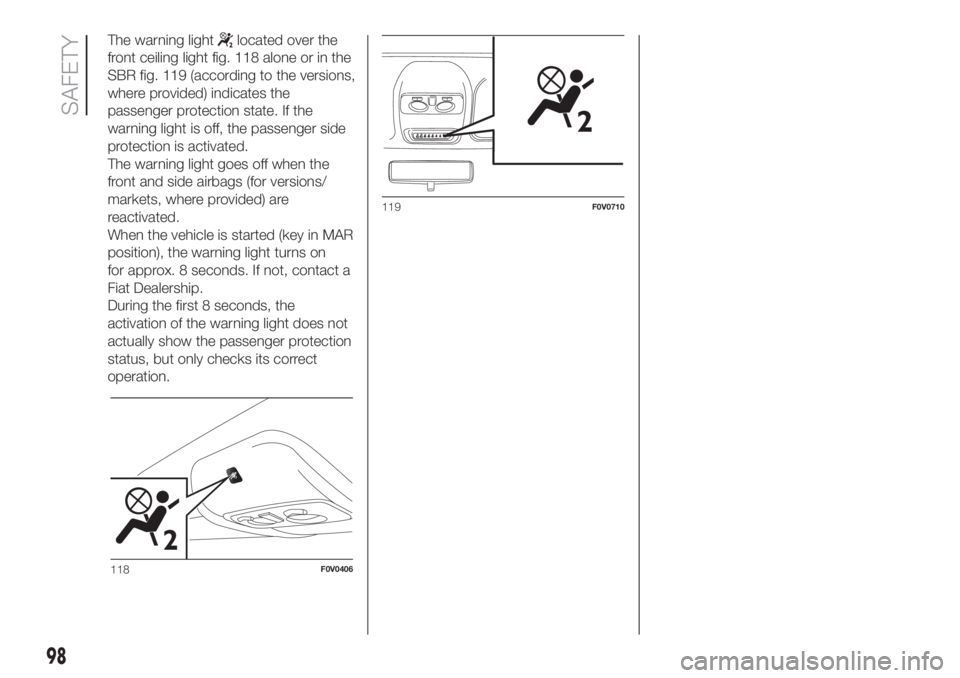
The warning lightlocated over the
front ceiling light fig. 118 alone or in the
SBR fig. 119 (according to the versions,
where provided) indicates the
passenger protection state. If the
warning light is off, the passenger side
protection is activated.
The warning light goes off when the
front and side airbags (for versions/
markets, where provided) are
reactivated.
When the vehicle is started (key in MAR
position), the warning light turns on
for approx. 8 seconds. If not, contact a
Fiat Dealership.
During the first 8 seconds, the
activation of the warning light does not
actually show the passenger protection
status, but only checks its correct
operation.
118F0V0406
119F0V0710
98
SAFETY
Page 102 of 272

WARNING
77)Do not apply stickers or other objects to the steering wheel, the dashboard in the passenger side airbag area and the seats. Never put
objects (e.g. mobile phones) on the passenger side of the dashboard since they could interfere with correct inflation of the passenger airbag
and also cause serious injury to the passengers.
78)Always drive with your hands on the rim of the steering wheel so that the airbag can inflate freely if required. Do not drive bent over the
steering wheel, but rather sit upright with your back firmly resting against the seat back.
79)The airbag deployment threshold is higher than that of the pretensioners. For collisions in the range between the two thresholds, it is
normal for only the pretensioners to be activated.
80)The airbag does not replace seat belts but increases their efficiency. Because front airbags are not deployed for low-speed crashes, side
collisions, rear-end shunts or rollovers, occupants are protected, in addition to any side bags, only by their seat belts, which must therefore
always be fastened.
81)In some versions, in the event of a failure of the
LED (located on the front ceiling light), thewarning light on the instrument panel
turns on and the passenger side airbags are deactivated.
82)When there is an active passenger airbag, DO NOT install rearward facing child restraint systems on the front seat. Deployment of the
airbag in a crash could cause fatal injuries to the child regardless of the severity of the collision. Therefore, always deactivate the passenger
side airbag when a rearward facing child restraint system is installed on the front passenger seat. The front passenger seat must also be
positioned back as far as possible in order to prevent the child restraint system from coming into contact with the dashboard. Immediately
reactivate the passenger airbag as soon as the child restraint system has been removed.
100
SAFETY
Page 104 of 272
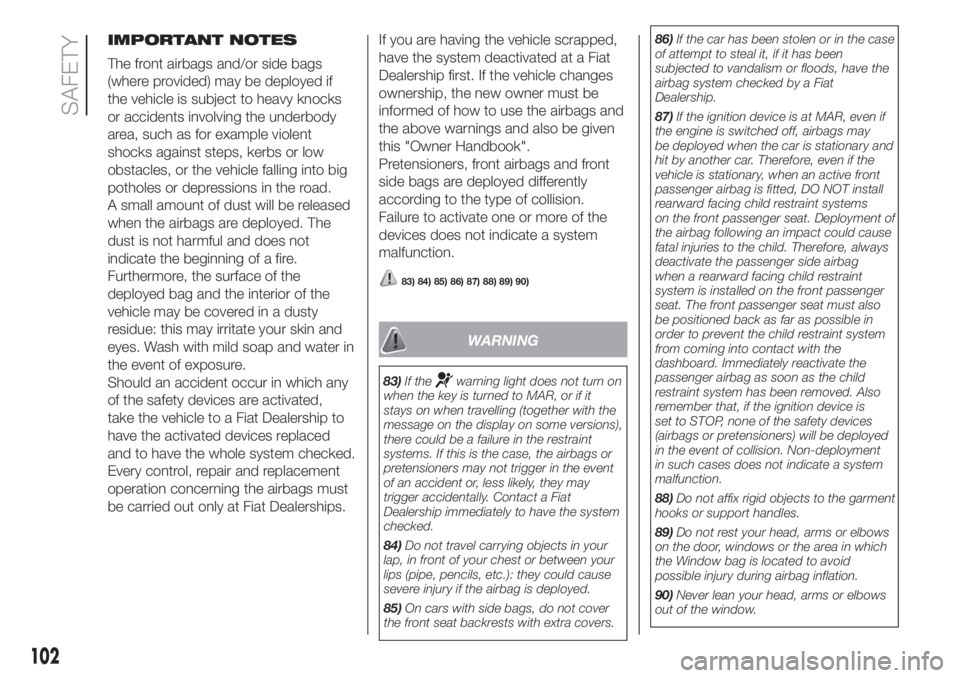
IMPORTANT NOTES
The front airbags and/or side bags
(where provided) may be deployed if
the vehicle is subject to heavy knocks
or accidents involving the underbody
area, such as for example violent
shocks against steps, kerbs or low
obstacles, or the vehicle falling into big
potholes or depressions in the road.
A small amount of dust will be released
when the airbags are deployed. The
dust is not harmful and does not
indicate the beginning of a fire.
Furthermore, the surface of the
deployed bag and the interior of the
vehicle may be covered in a dusty
residue: this may irritate your skin and
eyes. Wash with mild soap and water in
the event of exposure.
Should an accident occur in which any
of the safety devices are activated,
take the vehicle to a Fiat Dealership to
have the activated devices replaced
and to have the whole system checked.
Every control, repair and replacement
operation concerning the airbags must
be carried out only at Fiat Dealerships.If you are having the vehicle scrapped,
have the system deactivated at a Fiat
Dealership first. If the vehicle changes
ownership, the new owner must be
informed of how to use the airbags and
the above warnings and also be given
this "Owner Handbook".
Pretensioners, front airbags and front
side bags are deployed differently
according to the type of collision.
Failure to activate one or more of the
devices does not indicate a system
malfunction.
83) 84) 85) 86) 87) 88) 89) 90)
WARNING
83)If thewarning light does not turn on
when the key is turned to MAR, or if it
stays on when travelling (together with the
message on the display on some versions),
there could be a failure in the restraint
systems. If this is the case, the airbags or
pretensioners may not trigger in the event
of an accident or, less likely, they may
trigger accidentally. Contact a Fiat
Dealership immediately to have the system
checked.
84)Do not travel carrying objects in your
lap, in front of your chest or between your
lips (pipe, pencils, etc.): they could cause
severe injury if the airbag is deployed.
85)On cars with side bags, do not cover
the front seat backrests with extra covers.86)If the car has been stolen or in the case
of attempt to steal it, if it has been
subjected to vandalism or floods, have the
airbag system checked by a Fiat
Dealership.
87)If the ignition device is at MAR, even if
the engine is switched off, airbags may
be deployed when the car is stationary and
hit by another car. Therefore, even if the
vehicle is stationary, when an active front
passenger airbag is fitted, DO NOT install
rearward facing child restraint systems
on the front passenger seat. Deployment of
the airbag following an impact could cause
fatal injuries to the child. Therefore, always
deactivate the passenger side airbag
when a rearward facing child restraint
system is installed on the front passenger
seat. The front passenger seat must also
be positioned back as far as possible in
order to prevent the child restraint system
from coming into contact with the
dashboard. Immediately reactivate the
passenger airbag as soon as the child
restraint system has been removed. Also
remember that, if the ignition device is
set to STOP, none of the safety devices
(airbags or pretensioners) will be deployed
in the event of collision. Non-deployment
in such cases does not indicate a system
malfunction.
88)Do not affix rigid objects to the garment
hooks or support handles.
89)Do not rest your head, arms or elbows
on the door, windows or the area in which
the Window bag is located to avoid
possible injury during airbag inflation.
90)Never lean your head, arms or elbows
out of the window.
102
SAFETY
Page 106 of 272
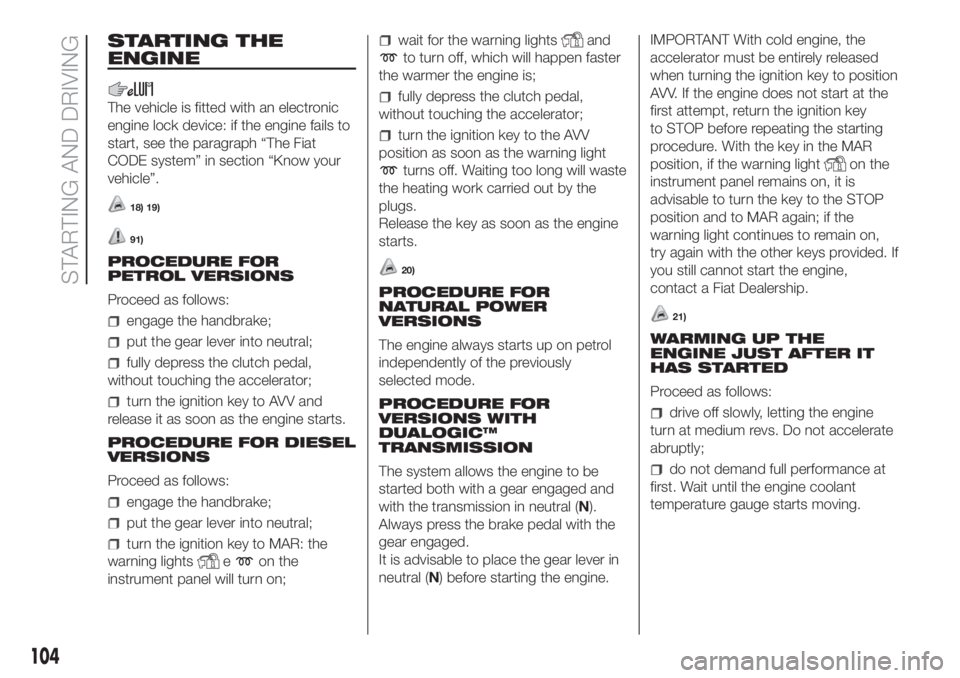
STARTING THE
ENGINE
The vehicle is fitted with an electronic
engine lock device: if the engine fails to
start, see the paragraph “The Fiat
CODE system” in section “Know your
vehicle”.
18) 19)
91)
PROCEDURE FOR
PETROL VERSIONS
Proceed as follows:
engage the handbrake;
put the gear lever into neutral;
fully depress the clutch pedal,
without touching the accelerator;
turn the ignition key to AVV and
release it as soon as the engine starts.
PROCEDURE FOR DIESEL
VERSIONS
Proceed as follows:
engage the handbrake;
put the gear lever into neutral;
turn the ignition key to MAR: the
warning lights
eon the
instrument panel will turn on;
wait for the warning lightsand
to turn off, which will happen faster
the warmer the engine is;
fully depress the clutch pedal,
without touching the accelerator;
turn the ignition key to the AVV
position as soon as the warning light
turns off. Waiting too long will waste
the heating work carried out by the
plugs.
Release the key as soon as the engine
starts.
20)
PROCEDURE FOR
NATURAL POWER
VERSIONS
The engine always starts up on petrol
independently of the previously
selected mode.
PROCEDURE FOR
VERSIONS WITH
DUALOGIC™
TRANSMISSION
The system allows the engine to be
started both with a gear engaged and
with the transmission in neutral (N).
Always press the brake pedal with the
gear engaged.
It is advisable to place the gear lever in
neutral (N) before starting the engine.IMPORTANT With cold engine, the
accelerator must be entirely released
when turning the ignition key to position
AVV. If the engine does not start at the
first attempt, return the ignition key
to STOP before repeating the starting
procedure. With the key in the MAR
position, if the warning light
on the
instrument panel remains on, it is
advisable to turn the key to the STOP
position and to MAR again; if the
warning light continues to remain on,
try again with the other keys provided. If
you still cannot start the engine,
contact a Fiat Dealership.
21)
WARMING UP THE
ENGINE JUST AFTER IT
HAS STARTED
Proceed as follows:
drive off slowly, letting the engine
turn at medium revs. Do not accelerate
abruptly;
do not demand full performance at
first. Wait until the engine coolant
temperature gauge starts moving.
104
STARTING AND DRIVING